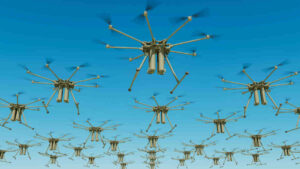Looking for a space stock? These ASX launches are out of this world

Pic: gorodenkoff / iStock / Getty Images Plus via Getty Images
Elon Musk fans have been checking their inboxes every five seconds this week, waiting for the golden ticket – a chance to join Starlink’s “Better Than Nothing Beta” test.
For the uninitiated, Starlink is Musk’s attempt to cover the globe in satellite-driven broadband. SpaceX has put at least 800 satellites into orbit, with several thousand to follow. Beta access to the service costs US$99 ($140) a month, plus US$499 ($700) for a setup kit.
Musk reckons that will give users at least a 50Mbps service, ranging up to 150Mbps – but currently, only in some US states. And that’s a rollout minimum speed, which is bound to improve as the bugs disappear and more satellites come online.
Satellites are big business, especially the Low Earth Orbit type which are blasting off almost daily on missions to send megaterabytes of data back to Earth on whatever, whoever wants to know about anything.
The price point of owning your own satellite constellation – or at least accessing one – is now… manageable. And you can bet there are ASX small caps lining up for a piece of the action. Several, in fact.
Kleos Space
After its radio eavesdropping satellite launch was delayed for months because of the pandemic, Kleos Space (ASX:KSS) is finally getting ready for blastoff.
If all goes well, India’s Polar Satellite Launch Vehicle will propel its payload into LEO at 8.30pm AEDT on November 7. Among its cargo will be four of Kleos’ radio frequency scouting nanosatellites, with more set to join them in orbit next June via a launch by SpaceX.
Of the 50 launches the Polar Satellite Launch Vehicle has made since 1993, there have been 47 successes, two complete failures and one partial one.
Facebook famously found out the hard way that a satellite launch is never guaranteed when SpaceX Falcon 9 rocket exploded on its launch pad two days before takeoff back in Setepmber 2016.
“Of course I’ll be nervous,” Kleos Space chief executive Andy Bowyer told Stockhead this week from Luxembourg.
“But it’s the culmination of an enormous amount of effort. It’s a good moment for everyone to enjoy. It’s the cherry on the cake, and it’s great to be at this point.”
The company has been planning for the launch since Bowyer and chief technical officer Miles Ashcroft co-founded the company back in 2017.
It’ll be a transformational moment for the company, Bowyer says, although he emphasises this will be the first of many satellite launches for Kleos, with up to 20 clusters planned.
“We can’t generate revenue until the satellites are in orbit,” he says. “As soon as the satellites are in orbit, we can start generating revenue.”
The company already has $8 million in contracts secured for its radio frequency data, with a pipeline of over 130 potential clients, equating to $80 million to $100 million in potential revenue.
“It’s always difficult to sell something that doesn’t yet exist,” Bowyer says.
Tiny satellites will detect radio waves
The company’s radio frequency data is aimed at governments around the world as well as global maritime companies, and data providers to those markets.
The shoebox-sized satellites won’t transmit imagery, but will instead work to triangulate radio signals to detect and locate hidden maritime activity.
In Australia and New Zealand, defence contractor SYPAQ has been appointed the exclusive agent for Kleos’ data, which would likely prove helpful for governments trying to monitor activities at sea such as smuggling, illegal migration, fishing, whaling and vessels in distress.
A subscription for a single user starts at $10,000 a month; a company with a five-user team might expect to pay $400,000 to $420,000 a year.
“It’s a very easy dataset to process and ingest,” Bowyer said.
According to Kleos, its only competitor is US-based HawkEye 360, a private company with three satellites in orbit that’s valued at $200 million.
Kleos’ market cap is $88 million; if it could achieve a similar valuation, its shares would be worth around $2.20. They were trading around 70c on Wednesday.
In honour of Kleos’ upcoming launch, here’s a look at some other ASX space plays.
Spy and Space Global
Spy and Space Global (ASX:SAS) shares are suspended and haven’t traded since January 2019. It went into voluntary administration in April.
But yesterday it announced that Virgin Orbit would take a 14.7 per cent stake in the company and provide $3 million in launch services to it, as Spy and Space works to launch a constellation of 50 nanosatellites for communication purposes.
Shareholders will be asked to approve the plans to recapitalise the company, which could see its shares reinstated for trading on the ASX.
Electro Optical Systems
Defence contractor Electro Optical Systems (ASX:EOS) has capabilities tracking space debris and satellites. That’s known as “space domain awareness” in the industry, or SDA.
EOS has suites of ground-based sensors across Australia monitoring objects in orbit to reduce the likelihood of collisions that could take down a pricey satellite.
EOS says Australia’s location in the Southern Hempisphere, its strategic longitudes and large land mass make it an ideal location for a distributed network of space domain awareness sensors.
The company is even developing lasers that could move space debris to new orbits to avoid collisions via many seconds of “harmless radiation pressure”.
The company announced earlier this month its space business had received a $5.1 million, two-year contract from the Australian government for “technical development”, without giving details.
XTEK
XTEK (ASX:XTE) has a processing technology that allows it to make things lighter and stronger — which is good news for anyone wanting to send stuff into space because it’s pretty pricey.
The company’s bread and butter is military – specifically, ballistics – protection, but it is taking a sidestep into the space industry due to growing demand.
UNLOCK INSIGHTS
Discover the untold stories of emerging ASX stocks.
Daily news and expert analysis, it's free to subscribe.
By proceeding, you confirm you understand that we handle personal information in accordance with our Privacy Policy.








